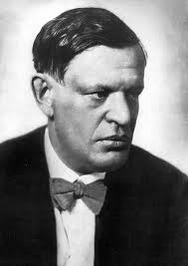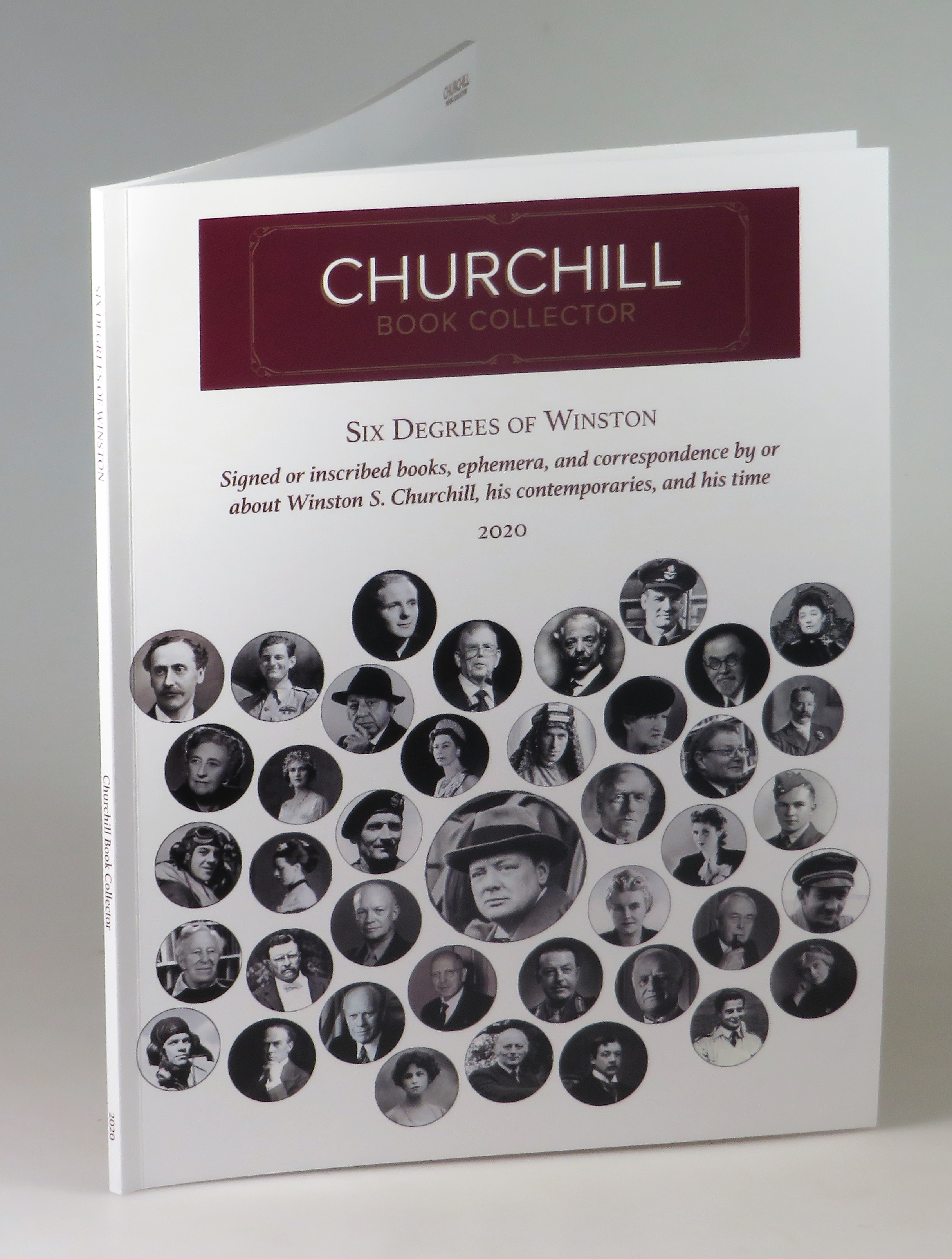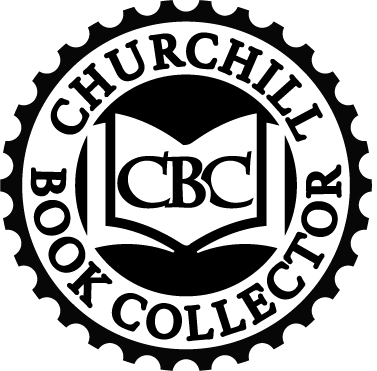Valentine’s Day seems an appropriate occasion to rhapsodize about connectedness. So I’m writing to introduce Six Degrees of Winston – our new catalogue which includes signed or inscribed books, ephemera, and correspondence by or about Winston S. Churchill, his contemporaries, and his time.
Of course, there’s some contrivance in the catalogue title; we like to keep it interesting, and merely titling a catalogue “Some more cool stuff you should buy” is not our style. That said, there’s a little more to the six degrees idea than mere marketing. Hence this post.
“Six degrees of separation” is the idea that any human being can be connected to any other human being through a chain of acquaintances with no more than five intermediaries. Frankly, it can seem hard to believe.
Skepticism seems warranted, particularly given that the idea is nearly a century old and originated as fiction. Conception of the phenomenon is attributed to a 1929 short story titled “Chains” by Hungarian writer Frigyes Karinthy. Despite origins in fiction, this notion that social distance disregards physical and social barriers, that an ever-swelling global population is still proximately interconnected, resonates in the zeitgeist.
Since 1929, a number of mathematicians, sociologists, and physicists have conducted various experiments more or less validating the idea. In the late 1960s, Stanley Milgram and Jeffrey Travers designed an experiment using the mail that tested and validated Karinthy’s idea, which they called the “small world” hypothesis. Others followed. And then came the Internet. Twenty-first century “six degrees” experiments conducted by the likes of Columbia University and Microsoft access the unprecedented data mine of electronic communication.
But we don’t have to rely on scientific experiment. For anti-vaxxers, climate change deniers, and others who poo-poo objective data, there’s a less methodical way to go about substantiating Karinthy’s notion – “Six degrees of Kevin Bacon”. That’s the parlor game where movie buffs challenge each other to find the shortest connection between any arbitrary actor and actor Kevin Bacon. For example – John Malkovich. He acted in Death of a Salesman with Dustin Hoffman who acted in Sleepers with Kevin Bacon. You get the idea.
The “six degrees” notion has proven not only persistently captivating, but also presciently persistent. The world’s population has roughly quadrupled since Karinthy’s story was published in 1929, but the addition of nearly six billion human beings has not appreciably increased the degrees by which we are separated.
Even as I type these words, engaging in the doubly archaic exercise of introducing a print catalogue intended to sell items of paper and ink, the cultural prairie fire of social media is – for better or for worse – validating the perceptive imagination of Frigyes Karinthy.
Which, of course, doesn’t tell you anything about what this has to do with Winston Churchill and our shiny new catalogue.
A number of “six degrees” inferences pertain.
First, as the contents of our catalogue demonstrate, Churchill’s “remarkable and versatile” life was connected to a tremendous quantity and variety of extraordinary people.
Second, who we are is affected by those to whom we are connected – whether by direct experience and association or mere acquaintance and regard. An individual’s “six degrees” are the gut bacteria of their personality – prolific, symbiotic, cumulatively vital, and experientially inseverable.
Third, the “six degrees” hypothesis reminds us that many distances – whether between people or between divergent places and perspectives – may be less than we suppose. But the sundering distances created by time are different.
History recedes. Not just in time, but in relevance and relatability. “Now” crowds “then”. “Is” eclipses “was”. “We” decays to “they”. Degrees of separation lengthen with years. In the words of someone we tend to quote, “History with its flickering lamp stumbles along the trail of the past, trying to reconstruct its scenes, to revive its echoes, and kindle with pale gleams the passion of former days.” An understanding and appreciation for history enables the relatably small world of the six degrees hypothesis to fend – at least to a degree – the depredations of time.
Which returns me to our catalogue – and a bit of apropos bookseller numerology.
There are six times six items offered in Six Degrees of Winston. These include the signatures of sixty-six individuals. Winston Churchill’s signature is found in several catalogue items, but the balance of the signatures are those of individuals connected to his life and labors – as is he to theirs.
Among the sixty-six are prime ministers and presidents, generals and field marshals, historians, photographers, novelists, soldiers, relatives, and royalty. We did not pull off a literal “A to Z” list, but we did make A to W. Here’s the full list of signatures:
Field Marshal Harold Rupert Leofric George Alexander, first Earl Alexander of Tunis
Emma Margaret “Margot” Asquith, Countess of Oxford and Asquith
Herbert Henry Asquith, 1st Earl of Oxford and Asquith
Roy Asser
Wing Commander P. P. C Barthropp
Wing Commander R. P. “Bee” Beamont
Squadron Leader G. H. “Ben” Bennions
Air Vice-Marshal H. A. C. Bird-Wilson
Air Commodore P. M. Brothers
Henry Worthington Bull
Pamela Frances Audrey Bulwer-Lytton (née Plowden), Countess of Lytton
Dame Agatha Mary Clarissa Christie, Lady Mallowan
Baroness Clementine Ogilvy Spencer-Churchill
Jeanette “Jennie” Spencer-Churchill
Sir Winston S. Churchill
Winston S. Churchill (namesake grandson)
Sir Julian S. Corbett
Air Marshal Sir Denis Crowley-Milling
Group Captain W. D. David
Air Commodore A. C. “Al” Deere
Edward John Barrington Douglas-Scott, 3rd Baron Montagu of Beaulieu
Squadron Leader B. H. Drobinski
Flight Lieutenant J. H. Duart
Dwight David Eisenhower
Gerald R. Ford, Jr.
Air Chief Marshal Sir Christopher Foxley-Norris
Sir Martin Gilbert
Herbert John Gladstone, 1st Viscount Gladstone
Group Captain T. P. “Tom” Gleave
John Golley
Ethel Anne Priscilla “Ettie” Grenfell, Baroness Desborough
William Henry Grenfell, 1st Baron Desborough
Bill Gunston
Douglas Southall Freeman
Wing Commander N. P. W. Hancock
Squadron Leader C. Haw
Commander R. C. Hay
Freddie Hurrell
Yousuf Karsh
Group Captain C. B. F. Kingcome
Colonel Henry Gaston Lafont
Richard M. Langworth
Arnold Walter Lawrence
Thomas Edward Lawrence
Sir Reginald Lister
Clare Boothe Luce
Alfred Lyttelton
Edith Balfour Lyttelton
Air Commodre A. R. D. MacDonell
Squadron Leader M. J. Mansfield
Kimon Evan Marengo (nom de plume “Kem”)
Brian Masterton
John McClelland
Field Marshal Bernard Law Montgomery, 1st Viscount Montgomery of Alamein
Wing Commander A. G. Page
Wing Commander P. L. Parrott
Michael Pierce
Theodore Roosevelt, Jr.
Group Captain D. F. B. Sheen
Wing Commander F. M. Smith
Walter Ernest Stoneman
Wing Commander J. E. Storrar
Millicent Fanny Sutherland-Leveson-Gower, Duchess of Sutherland (nom de plume Erskine Gower)
Harold John “Jack” Tennant
Wing Commander G. C. Unwin
Helen Venetia Vincent, Viscountess D’Abernon
Harold James Wilson, Baron Wilson of Rievaulx
Lady Cornelia Henrietta Maria Wimborne
Elizabeth Alexandra Mary Windsor, Queen Elizabeth II
Each of the thirty-six artifacts in the catalogue signed by one or more of these individuals is a tangible link, a flicker limning that “trail of the past”, and of course, a collectable connection to Winston Churchill. We leave it to you to count the degrees.






